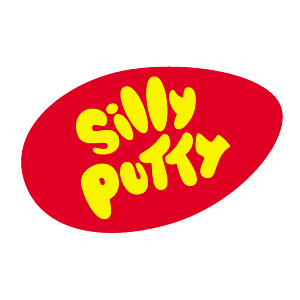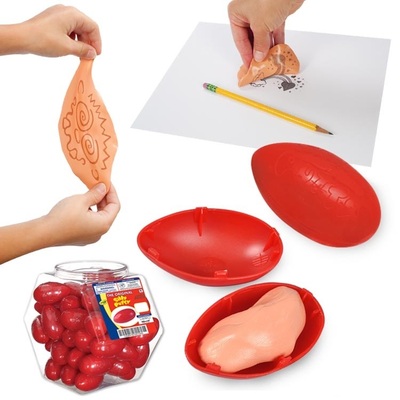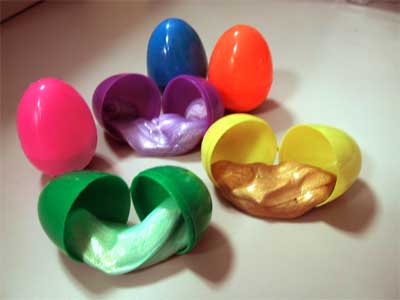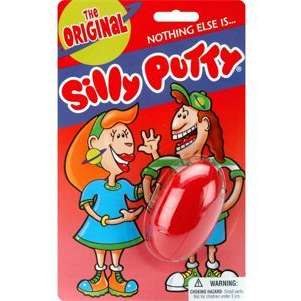|
In honor of Easter and all great things that come in eggs and shells, I give you the Silly Putty. And for those of you living under a rock, Silly Putty is a toy that feels rubbery made of silicone polymer. It comes in a plastic egg, where the beige colored material is malleable thus taking finger prints and picking text from newspaper, all the while it bounces and rips completely in half.
Interestingly enough, Silly Putty is a derivative of WWII rubber shortages, where Japan controlled a majority of the rubber-producing countries located in the Pacific Rim. The US government funded research for developing synthetic rubber, where as a result Silly Putty was invented. Down Corning and General Electric invented this material around the same time, but neither were able to devise a practical purpose for it's use, as it is not rubbery enough to construct rafts, tires, gas masks, etc. After concluding the material serves no real purposes, Peter Hodgson then marketed the material as a toy, where he claims to have sold 250,000 in first three days and later after it's merging with Crayola the product's annual sales exceeded two million eggs sold in 1987 and a total of 300 million sold since 1950, thus now being estimated at 20,000 sold daily. Again it is crazy to think that something denoted as purposeless sells 20,000 on a daily basis. Hypothetically the squishy material can be used in physical therapy and is considered as a stress reliever, although why not use regular biodegradable clay or Play-doh. Apparently Silly Putty can be used as a stain remover and lint brush, but when applied to a head of hair or any facial hair (especially while heated) good luck! Every year there are hundreds of kids are admitted to the Emergency Room because of Silly Putty in eyelashes, pubic, lodged in bodily crevices, etc. Luckily it is non-toxic, but how non-toxic is it really? Sure it is safe to rub all over your skin and such, and countless parenting blogs say swallowed Silly Putty by either kids or pets is ok. It's like gum or digests that way. But I beg to differ, what is the larger picture. How can you ingest something that will probably outlive you, is flammable yet resistant to microwaving?
2 Comments
Alane Harkin
4/16/2014 12:20:21 pm
Oh, we have to have some useless objects! I remember getting an egg full of Silly Putty and pressing it onto the colorful newspaper comics on Sundays. I learned about mirror images from the stuff. It isn't useless after all! :)
Reply
Leave a Reply. |
LAJ
100 Objects of Popular and Material Culture is an blog exploring the manifestations of human consumption and commodity-ization. The purpose of this experiment is to explore material and popular culture in contemporary society by using objects and concepts to prompt wider questions and reflections. So by emulating The British Museum's and Neil MacGregor's format of A History of the World in 100 Objects I plan to satirically analyze and reinterpreted 100 material culture objects over the course of 2014. Material Culture is the study of our culture's consumption of stuff; namely the manifestation of culture through material productions where people's perceptions of objects is socially and culturally dependent. With this, objects reflect conscious and unconscious beliefs on the the individuals who fabricated, purchased, or used them, and by extension the society where they live. So examining materiality, cultural truths and societal assumptions may be discovered. As anthropologist Arjun Appaduai states "in any society the individual is often caught between the cultural structure of commodity-ization and his own personal attempts to bring a value and order to the universe of things." Objects and commodities make up a much larger symbolic system consisting of want and need, socio-economic status, fashion, etc. Often times form follows function whether the commodity, market, and or consumer forever evolve around one-another. Philosopher Pierre Bourdieu's theories of capital flow full circle; where regardless if you are a minimalist or a hoarder the world is made up of things and everyone will leave their footprint on the earth. So by humorously analyzing marketed objects and concepts, hopefully this blog will provide further incite into ideas of over-consumption, a disposable society, consumerism vs. anti-consumers, planned obsolescence vs. sustainability, as well as the greater good of mankind and future generations. Archives
March 2015
Categories |




 RSS Feed
RSS Feed